Over the last 15 or so years in general, but especially in the last year, I quietly adopted some daily habits that have culminated in a zero waste kit that goes with me everywhere – while traveling and at home. If I’m out of the house, I’ve got my kit with me.
With my zero waste kit, some forethought, and a bit of discipline, I don’t generate any single-use waste when I go out – be it plastic, paper, or otherwise. It’s one little step towards sustainable travel and an encouragement in the sustainable tourism sector.
In this post I’ll show you how – and why – I do it.
Interested in Eco-Friendly and sustainable travel? These eco travel booking tools and sustainable travel companies will help you make the right choices and book travel that is good for you – and the world.
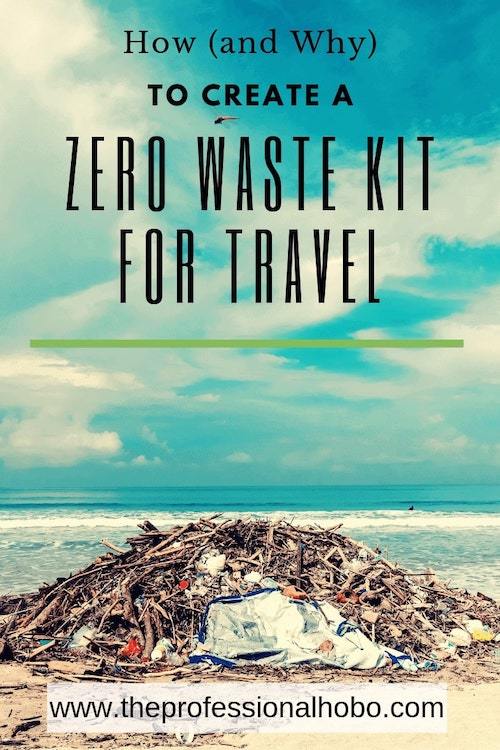
My Journey to Going Zero Waste
It’s important to note first off that I am not a distastefully evangelical environmentalist. I don’t boo and hiss at people who wield disposable coffee cups and bottles of water, take-out containers, and plastic grocery bags. I don’t judge. I just do my thing. Though if asked, I’m happy to discuss my views on single-use waste and my zero waste tips and alternative waste solutions.
Here’s a general timeline of how I developed my current mandate to eliminate single-use waste from my life and my zero waste lifestyle – on and off the road. Afterwards, I’ll zoom out to discuss why now is a critical time to examine the waste we generate and how we deal with it. Then, I’ll give you strategies for how to go zero waste and zero waste products you can use in your daily life to reduce the waste you generate. Going zero waste is easier than you think.
15+ Years Ago: Eliminated Bottled/Canned Drinks (Kinda by Accident)
My journey to zero waste travel was slow to start, when I eliminated bottles of water, as well as soda and other “disposable” drinks from my repertoire.
Cutting out soda and other sugar-filled drinks wasn’t an environmental decision; it was a calorie-counting thing. I didn’t like artificial sweeteners, and if I was going to watch my calories, I couldn’t justify “wasting” any part of my daily allotment on drinks. Lucky for me, I love water.
But I also couldn’t justify buying bottles of water – partly because of the financial outlay (I’ve always been frugal – at times to a fault), and partly because I’d already started hearing bad things about bottled water. Much of the talk was the same as it is today; bottled water is less regulated than tap water, and the plastic bottles are cheaply made (being “disposable” and all), which means the plastic leeches into the water itself. (More on that later).
2006: Reusable Grocery Bags
Long before reusable foldable grocery bags became en vogue, I was wandering through a funky store and found an adorable high-quality lightweight bag that folded in on itself to fit in a pocket when not in use.
Since I was about to embark on a new lifestyle of full-time world travel, I thought this bag could be a handy piece of travel gear. Not only was it immeasurably useful in a variety of scenarios (including buying groceries), it also lasted me eight years of almost daily use before it finally disintegrated.
Eight years! I can’t even fathom how many hundreds (thousands, even!) of plastic grocery bags I saved, and also how incredibly useful it was to have in my purse all the time.
More than being environmentally friendly, my reusable bag was convenient, and I loved using it.
2007: Lived on a Permaculture Property
One of the more pivotal experiences of my life happened when I volunteered in trade for free accommodation on a permaculture property in Hawaii. It was an incredibly challenging position in a variety of ways, but taught me what it takes to live off the grid.
Things like:
- How many hours the sun needs to shine in order to charge my laptop (and how much my adaptor continues to pull power if I leave it plugged in once fully charged). And also, what happens when the sun doesn’t shine (it meant a lot of early bedtimes with no power for lights or other devices).
- How much water we unconsciously waste – something I learned by having to walk to get my water, and to filter it all by hand.
And ultimately, how drastically we all are out of harmony with the earth and living in a terrifyingly unsustainable way.
Leaving the permaculture property was a shock to my system. The things I learned there reverberated through my life in a variety of ways, and I’m grateful for that experience. While I didn’t know it at the time, this experience planted the seed for my increasing concern about responsible tourism.
2008 (but Really 2018): Coffee Cups
Inspired by my permaculture property experience, in 2008, I wrote an article encouraging the world to stop using disposable coffee cups.
While my awareness of the coffee cup problem started way back in 2008, it was 2018 when I gave myself a personal challenge to never get coffee unless I had a reusable thermos, or unless I was staying in to drink it and they could serve it in a mug.
Elements like sacrifice and preparation became important. If I want coffee to go and don’t have my thermos, I don’t get coffee, plain and simple. And if I am meeting a friend for coffee, we have to choose a place that serves it in mugs. Thank goodness I have easy-going friends, because one fateful day last year, we met at a shopping centre, and visited five different places before we finally found one that would serve our coffee in mugs.
2019: Collapsible Tupperware and Cutlery
By this point I had a little “kit” of reusable items that were always with me, including a collapsible water bottle, reusable grocery bag, and travel mug. Inspired by my own personal challenge, I took it to the next level by seeing if I could eliminate all single-use waste generated when I go out. My cutlery fits into my collapsible tupperware container which fits into my purse, and I use it whenever I get street food, order take-out, or can’t finish my meal at a restaurant.
Now, I’m making videos about how to eliminate all single-use waste when you go out. Check it out:
How to Go Zero Waste – What’s Next?
It’s worth noting that my zero waste kit is intended to eliminate any single-use waste (not just plastic) that I would otherwise generate when I go out. I’ve not quite made the leap to fully eliminating single-use plastics, nor do I live in a completely zero-waste way, but I’m doing something more than nothing.
While I’m attentive to minimizing product packaging, I still buy groceries and other products that create waste. But I reuse plastic bags for produce, I shop when I can at bulk supermarkets that allow me to bring my own containers, and I generally do my best to be conscious of the waste I create.
And I’m pretty pleased with the results: on average I generate one small bag of garbage every two months. You can too, if you follow the strategies below!
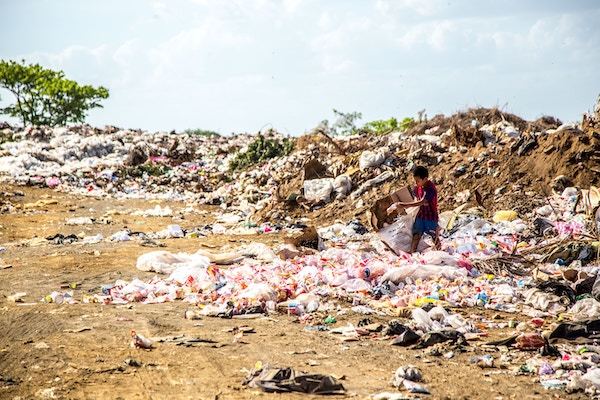
Current State of Affairs – Why It’s Important to Care About Single-Use Waste
We live in an out-of-sight-out-of-mind world.
Example: Where does our water come from? Why, the tap, of course. And the supply is inexhaustible, isn’t it?
It’s not. Just ask residents of Cape Town South Africa, who came dangerously close to having their municipal supply shut off entirely.
When I lived in the Australian countryside during their eighth year of severe drought, the water shortage felt very real; the stream (formerly a river) from where my water came ran through my backyard.
But when I would visit friends in Melbourne for the weekend, they’d say “you get to shower for as long as you like here! Isn’t that nice?”, despite them being on the same (dwindling) water supply.
It happens everywhere, in so many ways. Another example: meat comes from styrofoam packages in the grocery store, completely disassociated from the animal itself.
The same goes for garbage and recycling. We throw it away, and somebody else deals with it. The problem is, in many cases, it’s not being dealt with the way we think it is.
Let’s take some recycling statistics as an example. Did you know that many countries ship their recycling off to other countries to deal with?
In this fascinating series of articles by the Guardian exposing issues surrounding the global treatment of plastic, they say:
“Last year, the equivalent of 68,000 shipping containers of American plastic recycling were exported from the U.S. to developing countries that mismanage more than 70% of their own plastic waste.”
Canada was recently shamed when multiple containers of plastic were discovered to be contaminated (plastics weren’t properly cleaned or separated by you and I, and non-recyclable materials were in there too), and those containers were sent back. And it wasn’t just Canada either: the U.S., China, Japan, and Saudi Arabia also got slapped with their crap being returned.
Even if those containers of recycling were accepted and dealt with, Canada on the whole recycles just 11% of all plastics used. And the U.S. recycling statistics are even lower than that, at 9%.
Perhaps it’s time to stop feeling like we’re being environmentally responsible by tossing plastic into the recycling bin, and time to start considering the amount of plastic we consume to begin with.
Plastic – specifically single-use plastic – is becoming a global buzz word. Stories like this one by National Geographic reporting a whale that died from 20 pounds of plastic in its stomach (likely one of many whales and other sea creatures meeting with this demise) are inspiring the world to care about an increasingly dire state of affairs regarding plastic-contaminated oceans, water supplies, and more.
Personally, I understood the plastic situation in a whole new way when I was in Asia in 2017/2018. While living in (the bubble that is) Nimman in Chiang Mai Thailand, I got most of my meals at street-food types of places. While the Maya mall food court served meals on washable plates/bowls and offered real cutlery/chopsticks, the same couldn’t be said of normal street food stalls, where every serving (totalling hundreds a day, per stall) came in a plastic bag or styrofoam container with plastic cutlery.
Then there’s the prolific milk tea, bubble tea, and juice joints. I watched locals and tourists alike devour multiple drinks per day, each served in a plastic cup with a plastic lid and a plastic straw. By early afternoon, garbage bins (garbage, not recycling) were literally overflowing with plastic cups.
My understanding hit critical mass in Hoi An, Vietnam. While spending six weeks there in 2018, I took a cooking class on a river cruise boat. We putted out of the picturesque colourful Hoi An harbour, made a turn, and headed down the river. As soon as we were out of the main hub (where tourists roam), I noticed the riverbanks. They were lined with layers of plastic waste. Water bottles, cups, cutlery, styrofoam, and more; so thick along each bank that it looked like Hoi An was actually built on plastic.
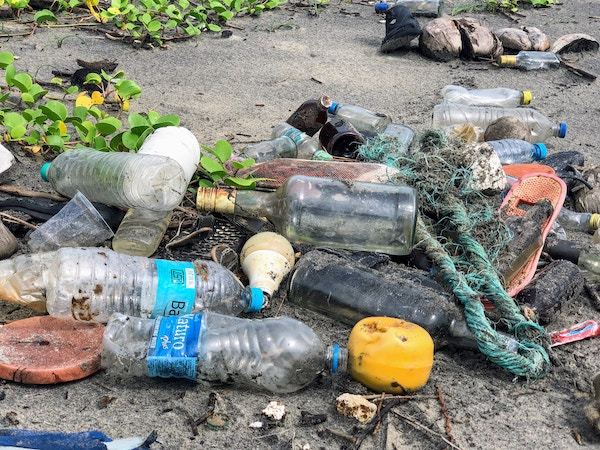
How the World is Responding – Single Use Plastic Bans and Waste Treatment Practices
This is intended to be a hopeful article – not a hopeless one! The world is catching on to the single-use plastic crisis.
Airlines are reducing and invoking single-use plastic bans. Quantas was the first to announce their plans to remove 100 million single-use plastics from their flights by 2020, and others are lining up with similar initiatives. Marriott – the world’s largest hotel chain – is eliminating all plastic toiletry bottles.
The European Union is banning single-use plastics by 2021, which has inspired other countries to snap to attention and follow suit with similar timelines.
When I was living in Switzerland in 2012, even then, the treatment of waste was mind-boggling for me. Everything had to be meticulously cleaned and separated a dozen different ways. No chucking that can of beans into the recycle bin, no sir-ee. The paper label had to be removed, the can thoroughly cleaned inside and out, and it even had to be collapsed a certain way.
Each form of waste was treated differently. Some were dropped off at the grocery store, others at the railway station, and on certain days/weeks, other forms of waste were collected.
I was astounded at the amount of work required to separate everything; I didn’t think such an onerous commitment would fly in North America. So I asked a Swiss friend what the incentive is; he replied that garbage bags are incredibly expensive, which motivates people to reduce their garbage as much as possible by recycling.
Not only that, but their waste is burned (cleanly) to generate power! While the infrastructure for such a system is incredibly expensive to build, I’m praying that other countries can find money in their budgets to develop similar practices.
Later, while spending two months in Japan in 2017, I saw a contradictory approach. Similar to Switzerland, waste separation was an art form. There was an inch-thick guide detailing how to separate and package up each form of waste, along with a dizzyingly confusing collection schedule. Again, everything had to be washed meticulously, and there was no margin for error. Each type of waste goes into a colour-coded transparent bag. If the waste collector sees inappropriate waste in the bag, they won’t collect it!
I was also surprised to discover that garbage cans are largely absent from streets and public spaces in Japan – and even more surprisingly, there’s also no litter on the streets. People take their waste home with them, and separate it accordingly!
All this is great. But their approach was contradictory in that nowhere else in the world have I seen things more over-packaged than in Japan. Everything (food and otherwise) was in a package, within a package, within another package. And almost every package was plastic of some sort. This says nothing of the plastic bento-box meals sold everywhere, which is a main form of sustenance for many Japanese people who work long days and don’t have time to cook.
So while the Japanese are excellent at separating their garbage, they could stand to produce a whole lot less of it.
We don’t need to wait for garbage practices to change or a single use plastics ban in our country to start reforming our ways today.
Right now.
You and me.
Here’s how.
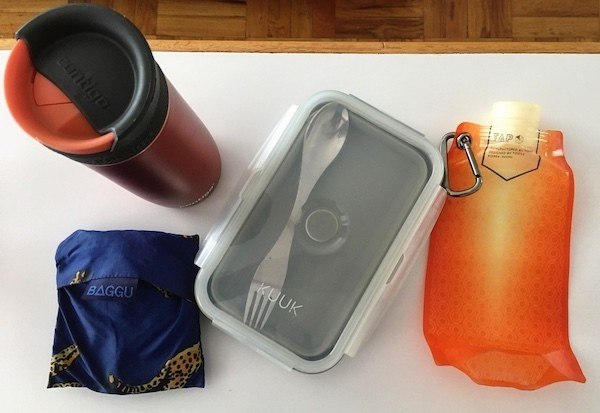
Reusable Products Breakdown: Alternatives to Bottled Water
Water is my absolute favourite drink. I devour two to three litres of the stuff daily. And yet, it has been 15+ years since I have bought a single bottle of water, including many years spent in countries where the water isn’t drinkable. See also: A Guide to Clean Water Around the World
Just in case you needed some ammunition to eliminate bottled water from your life, here’s what we’re looking at:
- According to The Guardian, a million plastic bottles are bought around the world every minute – which breaks down to 20,000 plastic bottles a second. The amount of bottled water purchased weekly in the U.S. alone can circle the globe five times.
- Plastic bottles take 450 years or more to break down and decompose. Some estimates push that number closer to 1,000 years. During this process, chemicals leach into the ground, micro plastic particles are released into the water (which affects the water we drink and the food we eat – new studies are showing that we are consuming plastic all the time) and animals choke on plastic bits when they mistake them for food.
- And, much as you might think that bottled water is free of contaminates, researchers discovered that 93% of bottled water tested contained micro plastic. This is double the amount of micro plastics found in tap water (as tested across more than a dozen countries on five continents).
So, perhaps it’s time to start working with what comes out of the tap. Here are some viable alternatives to bottled water.
Please note that if you click on the product links below, in most cases I will receive a small commission when you make a purchase. Thank you for your support!
Filtering/Treating Water – Best Backpacking Water Filters
If you live in a country where the water is safe to drink, it’s up to you how much (if at all) you want to filter it. While in Canada, I’m comfortable using a countertop Brita Filter (you can also get a faucet mount water filter version).
When you’re on the go and traveling, Life Straw is generally considered the best backpacking water filter. That said, Water-to-Go is my personal preference for water filter bottles. They provide safe drinking water from various sources (including filtering out all bacteria, disease, AND heavy metals), while contributing positively to environmental conservation. With the company moving all their bottles to this bioplastic, they are setting a new standard in sustainable travel gear.
For years, I used the SteriPEN Ultra UV Water Purifier which is great for treating water in countries where you can’t drink it, and I’ve used it all over the world. But – and I learned this one the hard way – it kills everything in the water, but it doesn’t filter out particulates like heavy metals (or micro plastics).
I haven’t truly put it through its paces yet, but I recently bought the Sawyer Mini Water Filtration System (shop for it at Amazon; one of a few Sawyer water filter products that are ideal for travel. It seems to combine the best of all the above filters.
Collapsible Reusable Water Bottle
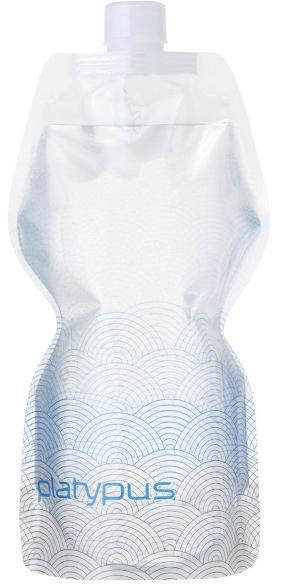
My reusable water bottle of choice (and I’ve been through a few different kinds!) is the 1 Litre Platypus Soft Bottle With Closure Cap. The screw top cap is leakproof, and the bottle opening is perfect to use with my SteriPEN Ultra UV Water Purifier when I’m in countries where the water isn’t potable (and is without particulates).
What I love about it is how light it is. When I’m not using it, I can roll it up and it takes up no space, so I have no excuse not to have it with me all the time.
Occasionally however, carrying around a full litre of water isn’t practical. Perhaps I’m going out for a short time and I only have space in my purse for a small bottle of water. For these occasions, I have a smaller collapsible bottle as well (Platypus has both 500ml and 1litre versions). But there are lots of options out there; have a look at collapsible water bottles and you can have your pick of the lot. For the smaller water bottles, I like the versions that have carabiners so it can easily be secured to a bag.
After a ton of constant daily use, I find my water bottles may start to discolour and smell bad, even with regular washing. To deal with this, I recommend using cleaning tablets (I prefer and use this natural brand linked to here) and/or regularly using a white vinegar or other natural treatment to disinfect and clean the bottle.
How to Eliminate Plastic Bags – With One of my FAV Reusable Items
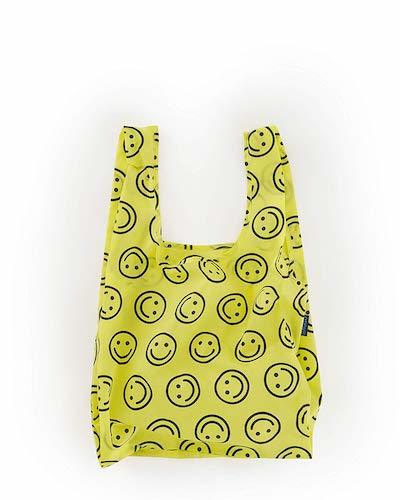
Far and away, my favourite reusable bag is made by BeeGreen. It’s a great size, can easily be slung over a shoulder or carried by hand, and can carry up to 50 pounds worth of stuff! It comes in a wide range of colours and designs, it’s washable, and it folds up into its own little pouch so it can easily fit into a pocket or purse. I never ever – never ever! – go out without it.
How to Eliminate Coffee Cups and Cold Beverage Cups
“It’s okay, Nora. It’s recyclable!” cheered a friend of mine when she ordered her coffee to go in a disposable cup, eyeing my reusable travel mug suspiciously, possibly fearing an environmental lecture (which I don’t give….normally. This article is a bit of an exception).
Well, first of all, disposable coffee cups and cold beverage cups aren’t recyclable, contrary to popular opinion. These cups are made of both paper and plastic (or wax); paper on the outside and plastic on the inside so the liquid doesn’t permeate the cup. This means it’s a non-separable mixed-material, and thus, it’s garbage. All this to say nothing of the plastic lid on top of the cup and (for cold beverages) the plastic straw.
Reusable Travel Mug / Collapsible Coffee Cup
For hot (and cold!) drinks, I love my Contigo Travel Mug. It’s sturdy, leakproof, and keeps hot drinks hot and cold drinks cold. It’s available in multiple sizes, and depending on the size you choose, it can easily fit in the side pocket of most daypacks.
BUT. From an ultralight travel perspective, it’s a bit of a pain. And there have been many times when I’ve spontaneously found myself at a coffee shop without my Contigo (which meant I didn’t order a coffee even if I wanted one).
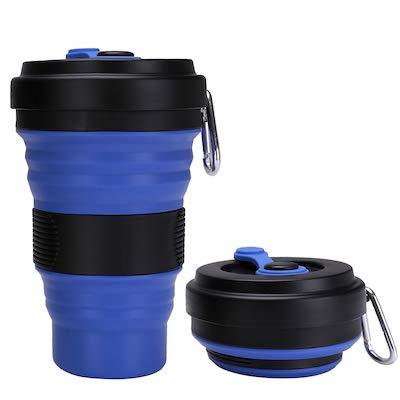
That’s why I recently got this collapsible travel cup (pictured here) and I love it! The only drawback is that it’s leak-proof, but not nearly as much as the Contigo is – I certainly wouldn’t toss it in my bag with liquid in it. But on the whole as a collapsible coffee cup, it’s a more practical addition to an ultralight zero waste travel kit. It easily fits in a purse or backpack, and is super light and compact.
How to Eliminate Food-Related Single-Use Waste
The last component of my zero waste kit turns heads every time I bring it out, which is quite a bit! For example, if I’m eating street food anywhere in the world, I use it. If I order takeout, I use it. If I’m at a restaurant and can’t finish my leftovers, I use it.
Collapsible Tupperware / Reusable Silicone Bags
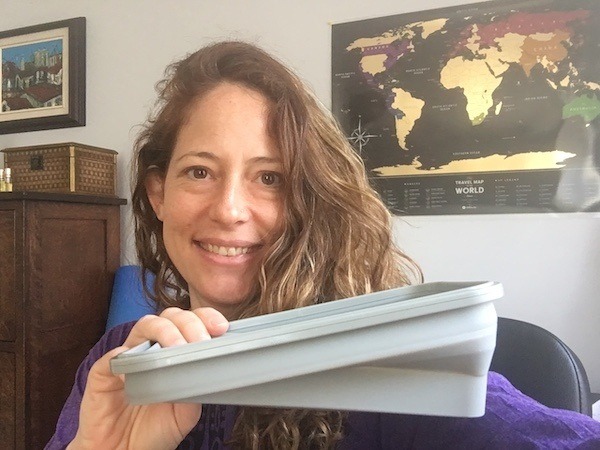
What am I holding in the picture above? It’s a collapsible tupperware container. Because it’s silicone, sometimes I have to wash it a couple of times to remove food smells and residue. The container (collapsed) fits into my purse, so I’m always ready for that street food or takeout or restaurant leftovers.
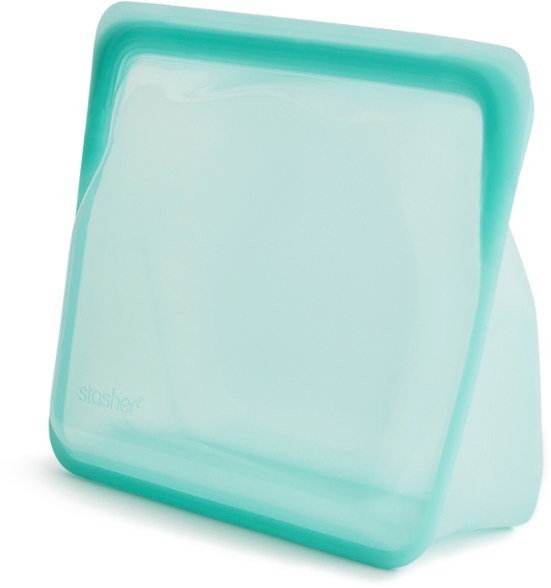
But even collapsed, these tupperware containers take up a bit of space (in order to make a zero waste kit practical, it needs to be easy to carry around all the time). That’s why I just got some reusable silicone bags like this one; when not in use I can roll it up and it will take up very little space.
Turns out they’re not as ideal as collapsible tupperware, which, with a full-sized flat bottom is easier to eat out of (for example in street food scenarios). So, while the silicone bag is great for packed lunches and snacks, I still keep the collapsible tupperware in my purse.
Travel Silverware
There’s one more step: travel silverware! Some travelers like to carry a full set of reusable cutlery with them, often with its own carry pouch and made of sustainable materials like bamboo. Me? I ordered one of these kits before realizing it took up way too much space for my liking. I just wanted something simple and easy to keep clean that can fits inside my collapsed tupperware!
I also don’t like traditional “sporks” because they’re often awkward to hold, and the fork side has a knife’s edge that can cut my lips. So, I have a full sized titanium spork, and it’s perfect (not to mention easy to clean and indestructible). Even in scenarios where my tupperware isn’t required, I can avoid using plastic cutlery by always having my spork with me.
How to Go Zero Waste – Putting it all Together
That’s a lotta kit! But it doesn’t take up a huge amount of space (I can fit it all in my anti-theft purse), and if I know I won’t need certain components (like the travel mug), I can leave them behind.
That said, I’ve found myself in scenarios where I don’t have one or the other component of my zero waste kit, and I’ve had to make some tough decisions. For example, it means just not getting that coffee when I’m spontaneously at a coffee shop with friends. And if I’m hungry and don’t have my tupperware with me, it’s not always easy to find food on the go that doesn’t generate waste. Sometimes it’s a matter of choosing whatever generates less waste rather than no waste.
Creating Habits
When describing my zero waste kit and system to a friend, she said “I have a reusable bag too! But I never remember to take it with me.”
That’s why it’s important to create habits. My reusable shopping bag is always (always!) in my purse. After using it, I immediately fold it up and put it right back in my purse….right away. I don’t even give myself a chance to put it anywhere else.
Before I leave the house, I consider what the outing may entail. Unless I’m going out for a very short time/specific task or going somewhere where bringing a full-sized purse is impractical, I have my purse, which always contains my Baggu foldable bag, a full 500ml collapsible water bottle, collapsible tupperware, and travel silverware. I’ve lost count of the number of times I’ve not intended to use my kit, but have indeed used it.
And while in the past I often didn’t have my Contigo travel mug with me (much to my own disappointment if I spontaneously wanted coffee to-go), my collapsible coffee cup is easy to stash in my purse.
But I’ll admit that sometimes it’s a pain. My purse is a bit heavy with a full water bottle and other accoutrements. I wish I could just got out without bothering with all the stuff. But realistically, most of the time I have my purse with me anyway, so it’s just an extra bit of weight to carry.
Now, this is a bit trickier for guys, who tend to just use pockets for their stuff. So fellas, if you want to do the zero waste kit thing, you may need to invest in a bag of some sort. There are some pretty slick manly messenger bags, slings, and day packs out there.
Even if you don’t go with the full monty every time, a Baggu reusable shopping bag takes up less space than a wallet. It’s a start!
What to do When Flying
While airlines are making big proclamations about reducing their plastic waste, it’s a juggernaut of an industry so it’ll take a while. And they don’t separate their waste either; it all gets collected in one big bag, which means no recycling.
I’m astounded at the number of plastic cups offered (per person!) on flights, especially long-haul flights. One for the pre-meal drink, another one to accompany the meal, and multiple passes through the cabin with water. While some people reuse the same cup, many others don’t.
Me? I refuse all drinks. I fill up all my water bottles (my 1 litre and my 500ml) after clearing security, and I drink that on the flight. If that’s not enough, I ask the flight attendants to refill my reusable bottle. Although they’re using bottled water, at least I’m avoiding the plastic cups.
And good news – airlines are going to start offering water stations so passengers can fill up their own bottles. And San Francisco airport recently announced that they’re eliminating all (overpriced) bottled water for sale (instead, making it easy for passengers to fill up reusable bottles after clearing security). Hurrah!
If you want a soda or mixed drink, then ask for the can without the cup. If they balk at that, tell them you are eliminating single-use waste like disposable cups; they’d be foolish not to support you in making such a request.
Meals are another matter. If you really want to be waste-conscious, you can bring your own snacks and meals on board. But realistically that isn’t always possible, and most food sold in airports comes in plastic containers that are even more wasteful. Many airlines serve their meals in reusable plastic containers which is great; the only remaining single-use plastic is the cutlery. Avoid opening the cutlery packet by bringing your own!
(The exception to these rules are when you’re flying in business class, where real glasses, plates, and cutlery are used. Yet another reason to fly up front! Here’s how I consistently fly long-haul in business class, for less than the price of economy.)
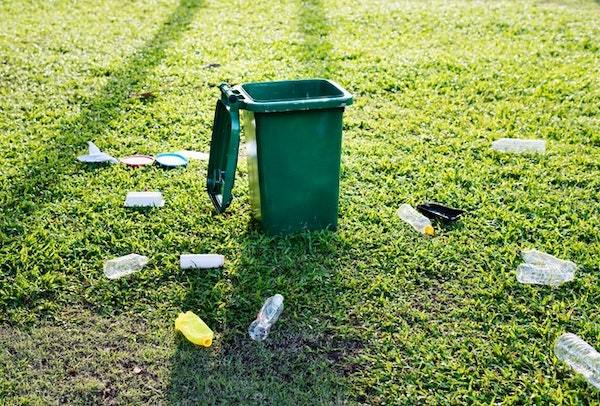
My Zero Waste Kit is Contagious
I was recently out on a hot summer day with some friends. I had finished the water in my collapsible water bottle, but I was still very thirsty. My friends (who were also thirsty) went into a food court in search of something to drink for me.
Feeling a bit uncomfortable and not knowing how to navigate the situation, I finally said “don’t worry about me, guys. I don’t do single-use waste, so I’ll just wait until I can find a water fountain.”
Their eyes lit up. “That’s so great!” they exclaimed. While I had no intentions of deterring them from their own mission to find something to drink, they quickly adopted my own quest to find a water fountain instead.
But I’ve also been poked fun at multiple times for my zero waste kit and environmental practices. I think in some cases people feel threatened by it (even though I do nothing to make them feel that way).
I was a little hurt when a good friend of mine repeatedly made fun of me in front of others for using my tupperware when we got takeout a few weeks prior.
“Laugh it up, buttercup! At some point, you’re going to be doing it too,” I said, my face reddening with a mixture of anger and embarrassment.
“Yeah, but only when I have to,” was her reply.
I said nothing. It’s not my place to force people to conform. Committing to zero waste takes effort and discipline and a whole lot of motivation. It has to come from within.
But later that day, another friend (who was present for the above conversation) said she has been inspired by me and that she’s getting reusable silicone bags for her kids’ snacks and lunches.
Two weeks later, the same friend who made fun of me for my tupperware, asked me where I got my collapsible water bottle. A week after that, she was sending me home with leftovers from a BBQ at her place, and after filling my tupperware, she had more food to give me and apologized for having to use a plastic bag.
People are inspired by others who are passionate and committed to a cause (without being judgemental or evangelical). The world is changing, and together we can change it all the more – one piece of waste (or lack thereof) at a time.

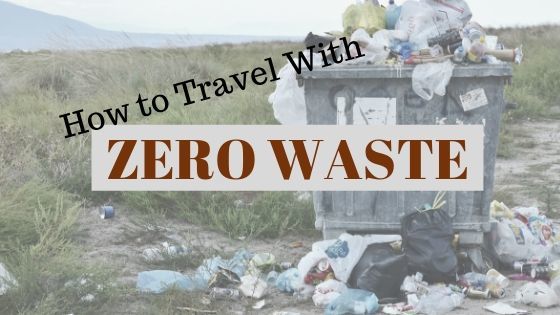


Great article, Nora. I always carry my bamboo coffee mug with me – and I often get a discount for using it :). Love my fish n chips wrapped in paper, then I shred the paper and compost it.
Hey Barb,
YES! Most coffee shops give discounts when you bring a reusable mug!
I used to have a bamboo coffee mug, until it fell out of my backpack and broke. 🙁 Now I ADORE my collapsible travel mug.
Hi Nora,
It’s one of the best ideas that you have been doing. No one will ever do this, except for the people who are working in the garbage areas to earn, not for the safety of our planet Earth. You have shown people what can be done to reduce the gallons of garbage to less. It’s an honor for you. I hope this work all the countries to keep the planet earth safe.
Well done Nora!
Thank you, Anson! I am enjoying the personal challenge, and also the feeling of accomplishment and pride that comes from knowing I’m doing a good thing, however small a thing it is.
Love this, it’s amazing how much waste you can reduce by incorporating more sustainable habits like bringing a reusable water bottle out with you. I must admit I do have a Life Straw bottle but I’m still a little nervous to try it out on unsafe drinking water I guess because we’re taught to only use sealed bottles or risk getting sick. It’s all about taking that first leap of faith!
Hi Francesca,
It totally is a leap of faith to use something like a LifeStraw! But in reality, it’s much safer than bottled water, which is shockingly unregulated. Just because it comes with a sealed cap, does NOT mean it’s healthy!
So true!
Late reply, but sharing in case it helps future readers… Do a little youtube search and watch thru-hikers filter water on the Continental Divide Trail, Pacific Crest Trail, etc, as they cover literally thousands of miles in the middle of nowhere. Seeing the algea-covered, animal-pooped, dead-frog-floating water tanks they sometimes have to dip from will assure you that they’ve done their research and only choose the best gear! Sawyer, MRI, MSR, Lifestraw, and other filters are tested and proven to work, and you can even research their nitty-gritty molecular level stats and studies. I trust my hiking filters all day long, rather than a bottle filled with unregulated, who-knows-what that came from who-knows-where? 🙂 Stop in at REI or your local outdoor shop for friendly, knowledgeable advice!
Brilliant, I enjoyed reading it! Thanks for such thorough information that covers so many topics.
Zero-waste (eco-friendly) lifestyle is indeed contagious. During the holiday with a friend in Bali, I was always picking up the trash from the beach. My friend watched me but didn’t really participate (I know when you clean-up someone’s trash for the first time it may feel awkward). But a few weeks later she sent me pics showing how much trash she collected at the lake near her house together with her boyfriend. I was extremely proud of her:)
Hi Yana,
YES! Doing good things is contagious! I’m finding that by doing my own thing for the environment, people are inspired to follow suit. Glad your friend jumped on the bandwagon! 🙂
I also carry lots of reusable kit around with me, and people give me strange looks, but I have grown a thick skin! I just wish more people would do the same! Great article, some useful tips and suggestions.
Hi Sarah,
I believe what starts out as a strange look can evolve into inspiration to follow suit! This kind of stuff is becoming more commonplace; they’ll eventually realize it’s cool. Keep leading by example, and people will start following suit. 🙂
Wonderful article and great resources. I’ve already several to my Amazon shopping cart. One or two small changes by each person can have an enormous impact on the planet. Thank you!
Amen, Michele! Glad you’re inspired to be a part of the change.
I really enjoyed this article thanks Nora! I suppose each day all we can do is our best to try and be better than the day before 🙂 (coffee is also my guilty habit!)
That’s totally it! As far as I’m concerned, doing my personal best is something to be proud of.
Genius! I love your zero waste kit! I’ve been trying to reduce my plastic consumption a lot lately too, especially the use of plastic bottles, wasteful plastic wrappers and packaging. I was traveling with reusable containers but it didn’t occur to me that they could also be collapsible. I’m going to need to update my travel gear before my next long term trip! Thank you so much for putting this together.
You’re welcome, Ionana! I love hunting down cool travel items.
Happy (zero waste) travels! 🙂
Love the Reusable Travel Mug / Collapsible Coffee Cup! I’m planning to buy one. Very informative. I was actually looking for these items. I’m teaching my children to be an advocate for the environment as well. As young as they are, they must understand the harmful effects it does in the environment. Thanks for sharing Nora!
Thanks, Kendrick! I think the best way to teach our kids (and anybody, really) is to lead by example. And by implementing good practices, your kids will naturally follow suit!
I so adore my collapsible coffee cup!
Thanks for posting this! I have been carrying a travel mug (usually two, for water and either a smoothie or tea depending on weather), food containers and utensils, for many years. Recently I added a folding knife which allows me to cut vegetables when traveling. I don’t understand people who go out without a bag. I always have a backpack (messenger bags are uncomfortable) or if I’m biking then a pannier.
I have found it very difficult to eliminate single-use packaging while traveling. At home I carry not just a big bag but also little ones for fruits, bulk bins and other snacks I may pick up. However, on the road, it is hard to find things in bulk or without packaging, and that are also suitable for use on the road. So I often find myself buying a bag of salad mix, a can of beans, a box of pasta, etc. It was worse in Scandinavia where nearly everything is wrapped in plastic. In the US you often need to find a special “natural foods” store in order to buy in bulk, and then even if I bought bulk beans, I don’t have a practical way to soak/cook them at campsites or hostels. Worse, I then have to carry the waste until I find a recycle bin. If I had saved all the cans, bottles, boxes and plastic wrapping, it would fill several large suitcases. Markets in the Baltics were better but not always ideal. Learning how to say “no bag” and “no receipt” is helpful. One idea I have is to focus my future travels on tropical countries with lots of fresh produce that you can buy at farmers markets, so very little processed/packaged food is necessary.
Any suggestions you have would be much appreciated.
Hi Jeremy,
Wow – you’re doing great stuff!
You’re right – eliminating all packaging for grocery items is almost impossible on the road.
For me, I do what I can (like using farmers markets as you suggest), and I avoid buying grocery items that are overpackaged (like in Japan – everything is a package within a package within a package!).
But that box of pasta or can of beans? I just make sure it gets recycled.
My most stringent efforts are to reduce/eliminate waste while eating and drinking out. 99% of the time I can do that with my little kit.
Happy (no-waste) travels!
Thanks for the valuable insights and tips. I’m now living in Asia and the amount of single use plastic here is alarming. I do try my best when at supermarkets to buy the unpackaged fruit and veg, but struggle when its comes to the cleaning supplies and things like toiletries etc. I know fling a little bit does go a long way but I hope one day I can also reach a zero waste lifestyle.
Hi Kaylini,
Yes, the ball dropped for me in Asia for sure, when I saw the amount of plastic waste littered just out of view.
Like you, the idea of going completely zero waste is a way off; this is why I’ve started by eliminating single-use waste. Onwards and upwards!
The Stasher silicone bag you pictured would be hard to eat from. These Stasher “bowls” would work better: https://www.stasherbag.com/pages/bowls
Great suggestion! These look fantastic. Thanks!
Thanks for the valuable insights and tips. I’m now living in Asia and the amount of single-use plastic here is alarming.
Hi Ava – I am disappointed, but perhaps not surprised, that it is still a big problem in some parts of Asia.